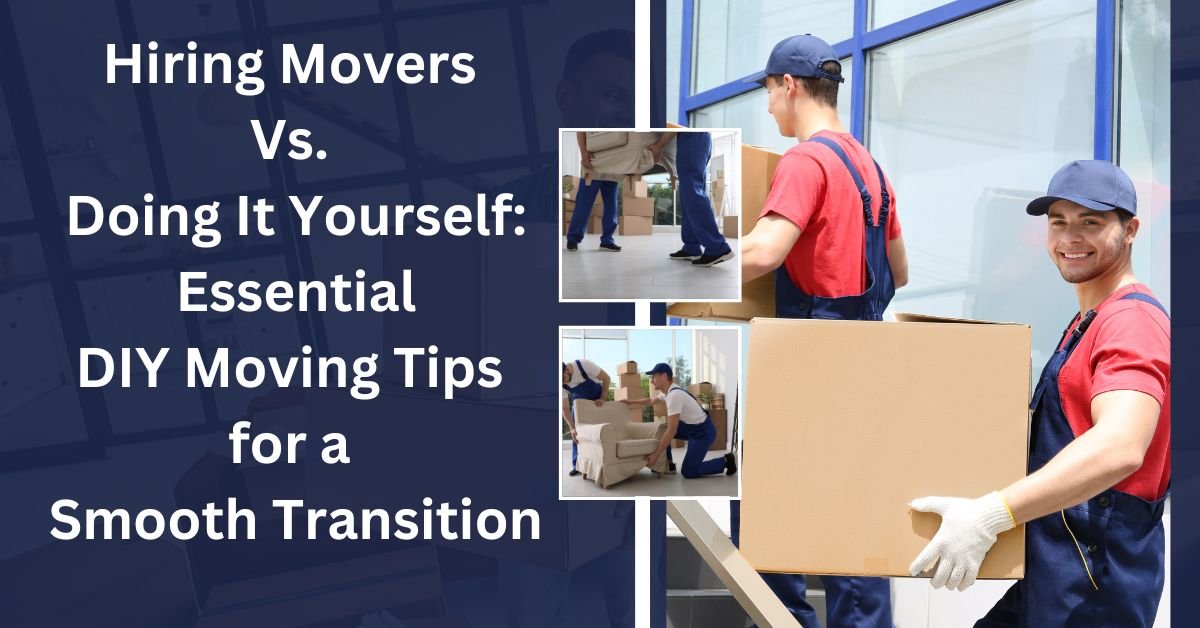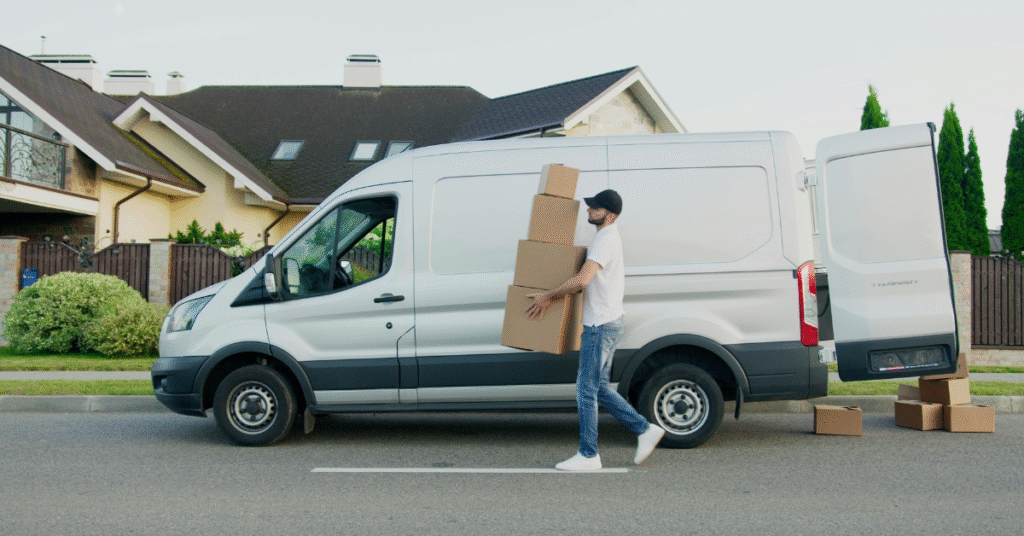Currently Empty: $0.00
Hiring Movers Vs Doing It Yourself: Essential DIY Moving Tips for a Smooth Transition

Moving is a significant life event that involves careful planning and decision-making. One of the biggest dilemmas for anyone moving is whether to hire professional movers or take on the task themselves. Each option has its own set of advantages and challenges. This comprehensive guide will help you understand the pros and cons of both hiring movers vs.DIY, while also providing essential self-move advice to make your move as smooth and stress-free as possible.
Understanding the Differences: Hiring Movers vs. DIY
When considering your move, you need to weigh the options carefully. Each method requires different levels of commitment, skill, and budget. Let’s start by breaking down the benefits and drawbacks of hiring a professional moving company versus self-move
Benefits of Hiring a Moving Company
One of the main reasons people hire professional movers is for peace of mind. Moving is stressful enough without having to worry about every small detail. Here are some of the key benefits of choosing to work with professionals:
- Stress-Free Moving
Professional movers take on the majority of the responsibility for your move, from packing to loading to transportation. This allows you to focus on other important aspects, like settling into your new home or handling paperwork. Their experience in efficient moving techniques minimizes delays and errors. - Efficiency and Experience
Movers have years of experience and a set process for moving different types of belongings, from small, fragile items to large, bulky furniture. They know the most efficient self-move techniques for loading and unloading, which can save a significant amount of time. - Insurance and Protection
One of the most important benefits of hiring movers is the insurance coverage. If something breaks or gets damaged during the move, professional movers’ insurance policies typically cover the costs. This offers an added layer of security and financial protection. - No Heavy Lifting
Moving heavy furniture or large boxes can be difficult and even dangerous for those without experience. If you choose to move yourself, implement safety measures like proper lifting techniques and using appropriate equipment, such as dollies and moving straps.
The Pros and Cons of Self-Move
While hiring movers might sound appealing, there are good reasons many people choose to go the self-move route. Let’s look at the pros and cons of self-move to help you make an informed choice.
Pros:
- Cost Savings
Perhaps the most significant advantage of a self-move is the potential for saving money. You won’t need to pay for labor or professional services, and you can manage the move at your own pace. For those working with a tight budget, this can be a huge benefit. - Control Over the Process
When you handle your own move, you have full control over how and when things are packed, transported, and unpacked. There’s no need to worry about coordinating schedules with movers or working within their timelines. This flexibility can be helpful if you’re moving locally or on a small scale. - Customizing Your Move
With a self-move , you can decide how to pack and arrange your belongings. You can choose your own packing materials and use self-move techniques that work best for your situation.
Cons:
- Physical Labor
A self-move requires significant physical effort. From packing and carrying heavy boxes to loading furniture onto the truck, you’ll need to be prepared for some heavy lifting. This can be a challenge, especially if you’re moving alone or have little help. - Time-Consuming
Without the expertise and resources of professional movers, a self-move can take much longer. From renting a truck to organizing your belongings, you may find the process slow and tiring. - Logistics
You’ll be responsible for everything, from renting the moving truck to making sure your belongings are securely packed. Managing all the logistics on your own can become overwhelming, especially if something goes wrong.
Comparing Costs: Professional Movers vs. Self-Move
Cost is often the biggest factor when deciding whether to hire movers or go the self-move route. Let’s break down the costs of each option so you can see which makes the most sense for your situation.
Professional Movers Cost Breakdown
The cost of hiring professional movers can vary depending on several factors, including the distance of your move, the size of your home, and whether you need additional services such as packing and unpacking. Here’s a general cost breakdown:
Hourly Rates for Local Moves
For local moves, movers typically charge by the hour. Rates usually range from $80 to $100 per hour for two movers and a truck. Larger teams or additional services will cost more.
Long-Distance Moves
Long-distance moves are generally more expensive and are typically priced based on the weight of your belongings and the distance traveled. On average, a long-distance move can cost anywhere from $1,000 to $10,000 depending on the size of the move.
Additional Services
Many moving companies offer extra services like packing, unpacking, or handling specialty items such as pianos or large appliances. These services often come at an additional cost but can be worth it for the convenience they provide.
To make the most informed decision, it’s essential to request quotes from the best moving companies near you and compare their pricing.
Self-Move Expenses to Consider
While moving without movers can seem like a cost-effective option, there are several expenses you need to account for when planning your budget:
Truck Rental
Renting a moving truck is one of the biggest expenses for a self-move move. The cost will depend on the size of the truck you need and the distance you’re moving. For local moves, truck rentals can range according to the long-distance rentals can add up quickly due to mileage fees and fuel costs.
Packing Supplies
You’ll need boxes, packing tape, bubble wrap, and other supplies to ensure your belongings are safely transported. While professional movers often include packing materials in their rates, you’ll need to purchase these items yourself for a self-move.
Don’t forget about the equipment needed to move heavy items. Renting dollies, furniture sliders, and moving blankets can add to the overall cost.
Insurance
While professional movers provide insurance for your belongings, a self-move may require purchasing additional coverage, especially if you’re renting a moving truck. This helps protect you in case of accidents or damages during transit.
When planning a self-move , it’s crucial to account for these expenses to avoid unexpected costs later on.
Essential Self-Move Advice for a Successful Move
If you’ve decided that a self-move is the right option for you, the key to success is organization. Moving can be overwhelming, but with the right self-move advice, you can streamline the process and reduce stress.
How to Move Without Movers: Step-by-Step Guide
Here’s a step-by-step guide to ensure your self-move move goes smoothly:
- Create a Moving Checklist
A moving checklist will help you stay organized and ensure that nothing gets overlooked. Include tasks like renting the truck, gathering packing supplies, and notifying utilities of your move. - Pack Strategically
When packing for a self-move, it’s essential to pack strategically to maximize space and protect your belongings. Use smaller boxes for heavy items like books and larger boxes for lighter items like bedding. This will make loading and unloading much easier. - Label Boxes Clearly
Labeling boxes is crucial for an organized move. Use a color-coded system or label each box with the room it belongs to in your new home. This will make unpacking much easier. - Rent the Right Equipment
To make your move as smooth as possible, rent a dolly, moving blankets, and straps to protect your belongings and avoid injury. - Load the Truck Efficiently
When loading the truck, place heavy items like furniture and appliances at the bottom and distribute the weight evenly. Pack boxes tightly to prevent them from shifting during transit.
Following these efficient self-move techniques will help you save time, reduce stress, and protect your belongings.
Packing Tips for Self-move
Packing is one of the most time-consuming aspects of moving, but it doesn’t have to be overwhelming. Here are some packing tips for DIY movers to help you stay organized:
Start Packing Early
Begin packing non-essential items like books, decorations, and seasonal clothing at least a few weeks before your move. A well-organized moving schedule can help you stay on track and avoid the last-minute rush that often accompanies a DIY move.
Use Plenty of Padding
Protect Fragile items wrapped in bubble wrap, towels, or blankets to protect them during transit. Make sure to fill any empty spaces in the boxes with packing peanuts or paper to prevent items from shifting.
Color Code and Label Boxes
Assign each room a different color and label boxes accordingly. This will make it easy for you (or your movers) to know where each box belongs in your new home.
By following these self-move advice, you’ll be able to pack efficiently and ensure that your belongings arrive at your new home safely.
Situations Where Hiring Movers is the Best Option
While a DIY move can be a great option for some people, there are certain situations where hiring movers is the best choice.
Long-Distance or Complex Moves
If you’re planning a long-distance or complex move, hiring professional movers is often the best option. Long-distance moves require more logistics, including managing travel arrangements and ensuring your belongings arrive on time.
Personal Experiences and Recommendations
Hearing from those who have experienced both hiring movers vs. DIY can offer valuable insights into the moving process. Many individuals discover that hiring professionals reduces stress and saves significant time, especially during larger moves. On the other hand, those with fewer belongings often find a deep sense of accomplishment after successfully executing a DIY move.
Utilizing self-move advice can enhance the experience, making it efficient and fulfilling. Whether you choose to hire movers or take on the challenge yourself, understanding the advantages and challenges of each option will help you make an informed decision that best suits your needs.
Is Hiring Movers or Going DIY the Right Choice for Your Next Move?
Deciding between hiring movers and opting for a DIY approach involves careful consideration of various factors, including costs, time, safety, and personal circumstances. Each option presents its own set of advantages and challenges, making it essential to assess your unique situation before making a decision. Whether you prioritize budget savings or convenience, understanding the pros and cons of each method can lead to a smoother moving experience.
Ultimately, the right choice depends on your specific needs, preferences, and the scale of your move. Whichever path you choose, being well-prepared and informed will significantly contribute to the success of your relocation. If you need professional assistance, consider reaching out to a residential moving company in Arlington, TX to help make your move easier and more efficient.





